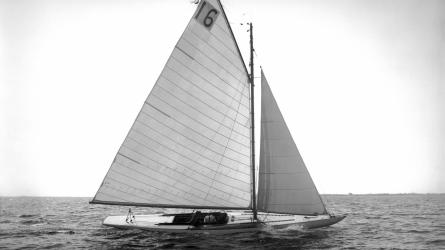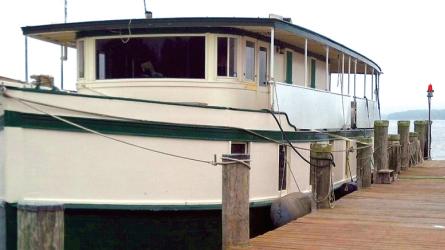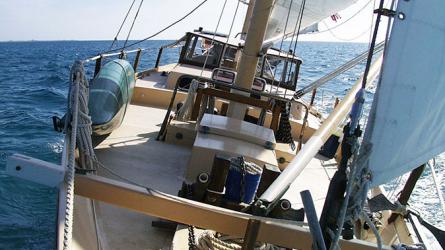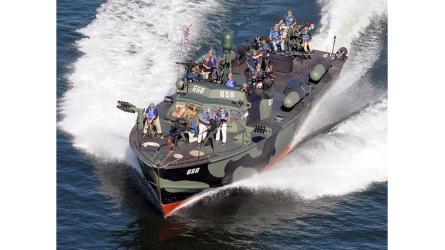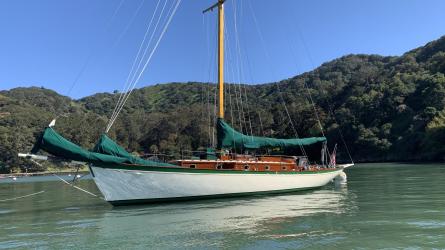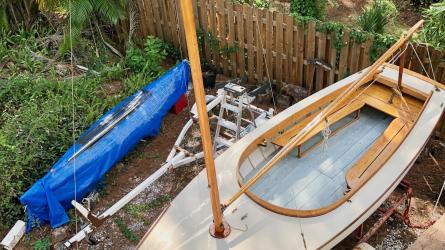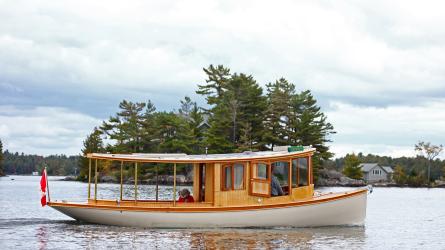In Caledonia
An Iain Oughtred pocket cruiser for a classic journey
An Iain Oughtred pocket cruiser for a classic journey
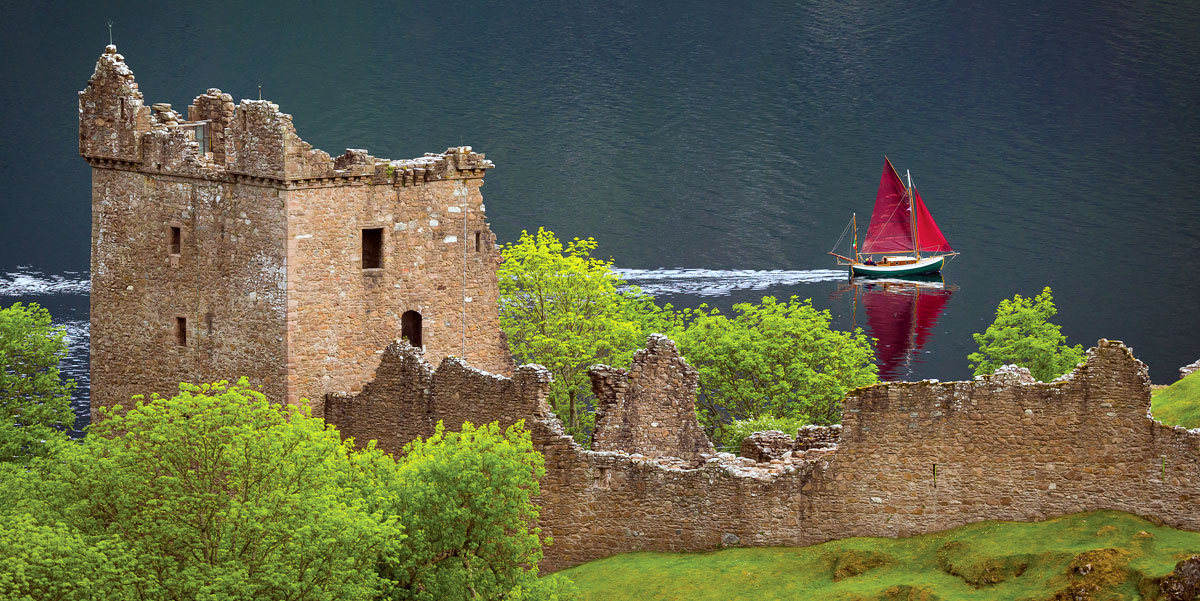
TAKATANI, a 19′ yawl built to Iain Oughtred’s Eu Na Mara design, sails in a light breeze before the ruins of Urquhart Castle while transiting the Caledonia Canal in Scotland.
Moving from Milan to Istanbul in 2008 marked the start of my progressive detachment from Italy. In the past few years, however, I have from time to time caught up with my Italian friend Andrea Oreni, with whom I have shared both the joys and the pains of sailing. Our usual meeting point, the Navigli area, is what remains of the ancient Milanese waterways so dear to Leonardo da Vinci. Between glasses of Jaegermeister, the discussion always ends up with talking about an adventure we shared that constitutes the cement of our friendship: the delivery of my gaff cutter, VILIA, from Greece to Istanbul, out of season, back in 2011.
During one of those Milanese nights out, Andrea proposed to me a boat holiday along the Caledonian Canal, the legendary waterway that cuts through the Scottish Highlands with the surgical precision of a scalpel. Two-thirds of its 52 nautical miles cross natural lakes; the rest is manmade. Since I am an anomalous Italian—I love a cold climate more than that of the Mediterranean—I accepted the proposal with cautious enthusiasm.
The trip, however, remained just an idea for a while. Then, one day I received an email from Andrea in which he told me that a mutual friend, the photographer-sailor Guido Cantini, would be part of the game. We thus earned a skilled seaman to the cause, but we still did not have a boat. This last piece of the puzzle came into being after a Skype session I had with the environmentalist Giacomo De Stefano, a dear friend and the happy owner of a number of wooden boats. He is known for his eco-journeys along the Po, Italy’s main river, and along the coasts of the Mediterranean. Above all, he is known for having rowed and sailed across the rivers and canals of Europe from London to Istanbul (5,200 kilometers overall, or 3,231 miles) in a tiny Iain Oughtred–designed Ness Yawl named CLODIA. That boat proved to be so ideal for such a journey that sometime later, when his father, Beppe, expressed the desire to buy a sailboat to be used in Venice, Giacomo suggested that he consider another Oughtred design—a sweet double-ended pocket cruiser design called Eun Na Mara. Beppe followed through on this, commissioning the Venice-based boatbuilder Roland Poltock to build a boat called TAKATANI. But he would barely sail her.
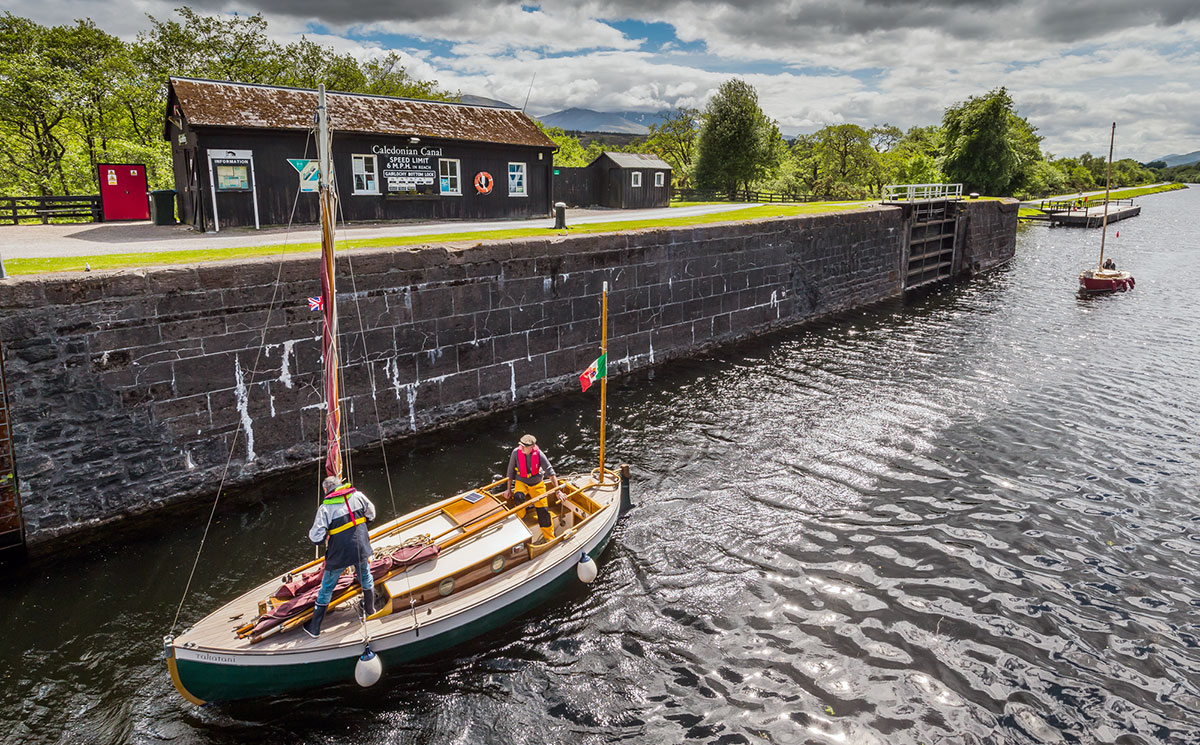
Freshly launched and yet to be set up for sailing, TAKATANI enters Gairlochy’s bottom lock, the gateway to Loch Lochy, at the outset of the voyage.
In August 2016, Giacomo informed me that Beppe had just died at age 85. “On July 18th,” Giacomo wrote in a touching email, “after a happy pruning of plants in the garden, my father decided to leave: he did it without suffering, while having his siesta.” A few weeks later, I got in touch with Giacomo in order to ask a few tips about the trip to Scotland and, most important, about the type of boat we should rent. I was sure his remarkable experience of freshwater navigation, waterways, and locks (he had crossed almost 350 of them on his longest journey) could be extremely valuable to our adventure. The first thing he was concerned about was that we have an electric motor, so we could enjoy Scotland’s natural beauty without toxic exhaust. The other requirements were a good sailing rig to exploit the favorable winds in the lakes, a limited draft to easily approach the shore and, if possible, a generous maximum beam, which would yield comfortable living space. Suddenly, after a brief silence, he said: “You may want to use TAKATANI for such a journey.”
And so with his characteristic calm (Giacomo often quotes the Dalai Lama: “If you are in a hurry, slow down”), he made available the boat his father had had almost no chance to enjoy. TAKATANI was somewhere in the Venetian hinterland, sheltered only by a tarp. Among Giacomo’s conditions were that he join the journey and that the voyage be environmentally sustainable. We would also share all the costs involved in the preparation and the boat’s transportation, via road, to Scotland.
I took the decisive next step and made a draft plan and a timetable. We would sail in company with my friends Paolo and Clive, who would be in SPINDRIFT, a Sidney DeWolf Herreshoff–designed Islander sloop. The need for a second boat—and a rental car to carry equipment—had arisen when Andrea decided he would make a documentary film of the voyage. TAKATANI and SPINDRIFT would take turns hosting two Swiss filmmakers, Fulvio and Claudio, whereas Andrea and the rest of the crew would rotate through the boats and the car in which he carried gear. I would sail the entire trip in TAKATANI, and in so doing would soon figure out how well suited this boat was, both in terms of functionality and aesthetics, for this journey.
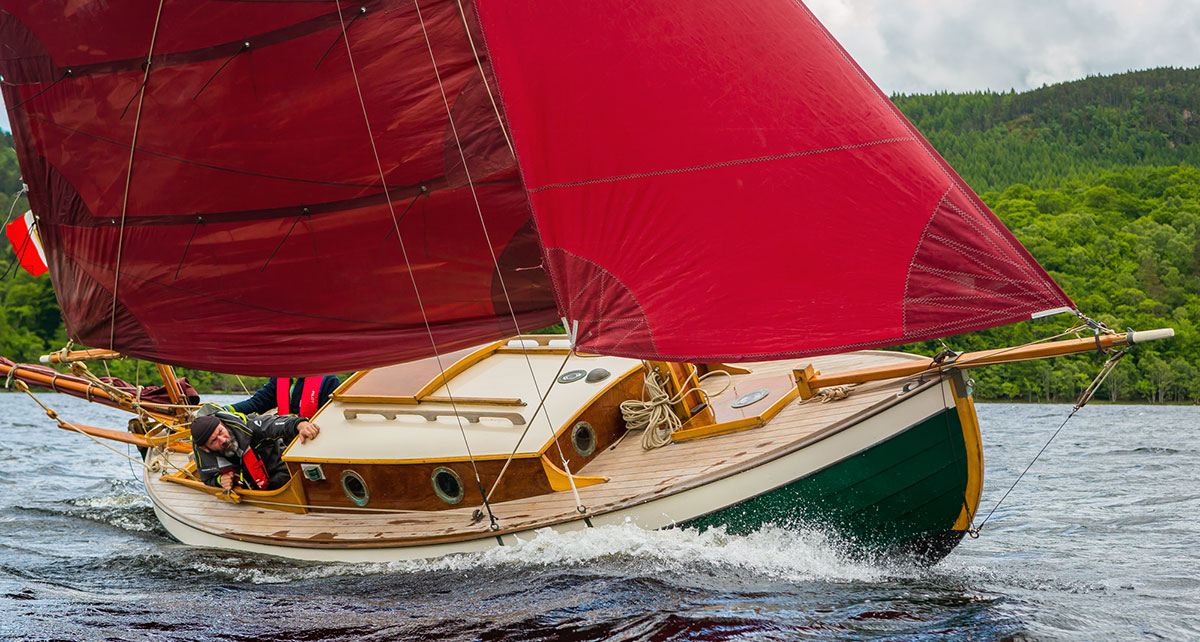
During the best sailing of her Scottish journey, TAKATANI charges along Loch Ness.
A Careful Balance: Trailerability and Accommodation
In the following days, I researched Eun Na Mara and was surprised to discover that it was successful as far away as Iain Oughtred’s native Australia and New Zealand. Half of the 60 or more existing boats of this design were built in those two countries.
I also got in touch with Nic Compton, the author of Iain’s biography. He told me that Iain, who is widely known for open boats rooted in a traditional aesthetic, received a commission in 1997 from Avery Brice, who wanted a pocket cruiser. His requirements were clear—so much so that the design process was a collaboration between him and Oughtred. “The result,” Compton wrote in the biography, “was the 19′9″ Eun Na Mara, a pretty double-ender which, with its gaff yawl rig and sturdy (rather than graceful) good looks, is in many ways untypical of Iain’s work.”
Nic also observed that “Her beam (6′8″) is carried well into her ends, giving her a chubby look which gives her a distinctively ‘friendly’ character.” This beam allowed for a remarkable amount of space below for a 19-footer. One of the Kiwi builders, Ian Milne, of Dunedin, called the accommodation of his boat, ISLESBURGH, “intimate.” He noted that, since the living area is a single space, “you do have to like each other well enough most of the time.” His boat had a simple galley to port and a chart table to starboard, and the V-berth could be configured as a double or two singles. His simple galley used a butane-fueled camp stove, and there was space for a portable toilet—to be used “by arrangement.”
After speaking with Andrea, Guido, and Giacomo, I found a one-week window in early June 2017 that suited us all. It was mid-March, so we had less than three months before starting the trip. Giacomo also heroically volunteered to prepare the boat alone, since none of the team was available to assist him for all the time required. It took him nearly a month to ready the boat, for she had been very much neglected while in storage for two years. He painted the bottom, tended to some joints that had dried out, added a slab-reefing system, and rigged the boat. He then spent three days driving, alone, the 965 miles (1,554km) from Venice to London, with the 1,600-lb TAKATANI trailing behind his old Mitsubishi Delica-type van whose 140-hp engine burns both diesel and vegetable oil.
On June 4, Giacomo and I met in the parking lot of Luton airport in England. For 20 minutes, he introduced me to TAKATANI, which I had seen only in pictures. She was enchantingly beautiful: her canoe stern, the shape of her deckhouse, and the absence of spars (which had been secured on deck for transport) highlighted the double-ender look. Had it not been for the propeller and for the slightly higher bow, it would have been easy to confuse one end with the other.
The next day, we arrived at Corpach, a few hundred yards from the westernmost lock of the Caledonia Canal, where we launched both boats. Rigging took only a few hours. The mainmast steps in a tabernacle and, being gaff rigged, is short relative to a Bermudan-rigged mainmast. The mizzenmast is unstayed. Stepping each of these spars was easy, and the rest of the rig preparation involved fitting the gaff and booms and lacing on the sails.
Finally I had the chance to become familiar with TAKATANI. Sleeping turned out to be very comfortable. I’m not very tall, just 5′7″, but Giacomo, who is 6′4″, found it comfortable, too. The sitting headroom is ample, and there is abundant stowage under the berths, in the bow (for the anchor rode), under the cockpit benches, and in the stern where the electric motor controller and charger are situated. Provisions for cooking were very basic; similar to Ian Milne’s boat, TAKATANI has a single-burner stove—though it was fueled by alcohol rather than butane. She has no sink, but one could be installed easily in the future. Giacomo plans to eventually add a coal-burning stove that “can keep the cabin warm even in subzero temperatures with just a fistful of coal.”
Like Ian Milne’s ISLESBURGH, TAKATANI has a portable toilet—also to be used by appointment. Giacomo, however, is planning to add a more permanent system with a simple holding tank. The portable toilet, however, was ideal for our short cruise along the Caledonian Canal, which has plenty of shoreside facilities.
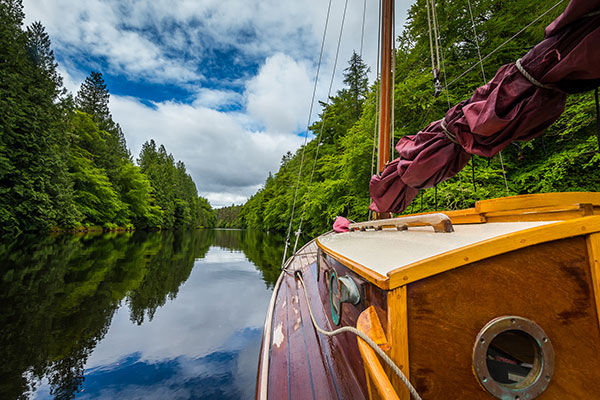
This is a typical sight along many of the human-made segments of the Caledonia Canal: still and clear waters lined by lush vegetation.
Motoring and Sailing
The following day, the adventure began. Accompanied only by the buzzing of our electric motors, we traveled 1 nautical mile from Corpach to Banavie, where we approached the legendary lock system called Neptune’s staircase. This succession of eight locks lifts boats 19 meters (62′) within just 440 meters (480 yards) of horizontal travel. It takes about 90 minutes to transit the locks, and the process proved to be both monotonous and edifying.
To accommodate Eun Na Mara’s mizzenmast, the tiller has a laminated loop built into it. The mizzen passes through this, allowing 11″ of tiller swing in either direction. Ian Milne found this feature to be “a little restricting for maneuvering in tight places, such as backing away and turning around to leave his launching area.” With the torque of the electric engine, however, we found that TAKATANI maneuvered easily—even in the tight confines of locks. After our trip, Giacomo even observed that “sculling, in experienced hands, would suffice in locks.” Our minds, however, were looking forward to the first lake, Loch Lochy, where we would finally hoist TAKATANI’s brown sails. The thought of steering her under full sail, in a fresh breeze, made me shiver with excitement. But a strong wind blew against us.
On our way to Gairlochy, a magnificent and sheltered basin all surrounded by lush vegetation, inhabited by wild geese, and with the 4,406′ (1,344m) Ben Nevis—the tallest mountain in the British Isles—well in sight, I noticed that Giacomo was thoughtful and unusually silent. He was almost a stranger aboard his own boat, all furled in his yellow oilskin under a light rain. As if it had not rained enough since the beginning of the journey, more rain fell overnight.
After a sleepless night, Giacomo summoned all of us to the only dry place in all of Gairlochy, a small laundry, where he announced he would not continue the journey. A nervous breakdown, his father’s recent loss and his mother, Marisa’s, illness, and the poetic beauty and solitude of Gairlochy told him to stop and to reunite with us at the end of the voyage. I did not try to make him change his mind because I know what happens when a voice inside tells you “stop!”
Giacomo gave us an accelerated course on TAKATANI’s running rigging, standing rigging, and other gear and features, and then he left the boat with Guido and me. It is a standard setup: the halyards for the gaff main and mizzen cleat at the base of the mast, and the sheets are led ergonomically to the cockpit. The jib is set flying on the bowsprit; its tack is fixed to a traveler, which is hauled out to the tip of the bowsprit before the sail is hoisted. Two deep reefs in the main allow for a variety of reefing options—including dousing the main entirely and proceeding under just jib and mizzen—which was how we first sailed TAKATANI.
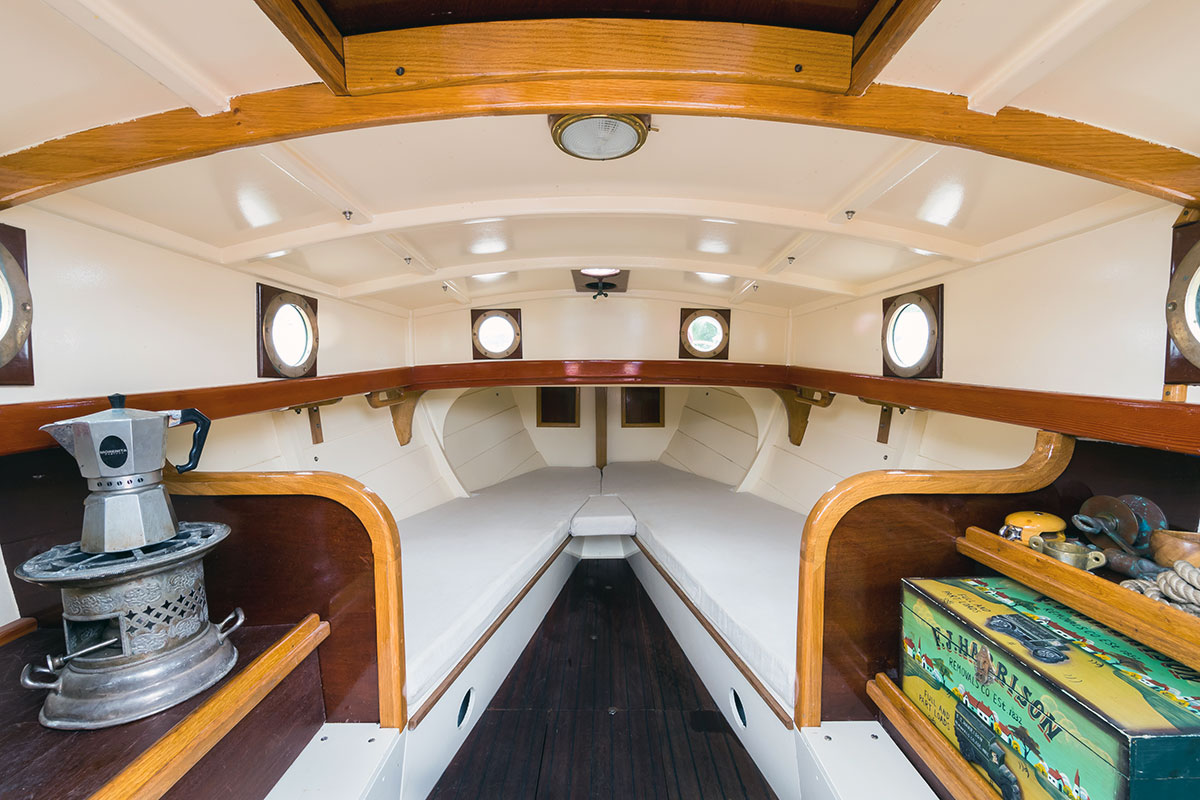
TAKATANI’s basic interior has long berths and ample sitting headroom. The burner to port reportedly belonged to the crew of the royal cutter BRITANNIA, which was scuttled at St. Catherine’s Deep, near the Isle of Wight, on July 10, 1936.
We hoisted sail—just the headsail and mizzen—on Loch Lochy shortly after 9 a.m. The sail combination was dictated by prudence, as we’d simply had no time to practice reefing while docked. In time-honored tradition of sailing under “jib and jigger,” the boat balanced nicely and there was no drama. However, we needed a little more power from the mainsail, and in the following days we would come to appreciate the simplicity of TAKATANI’s slab-reefing system, which is quick and efficient. Overall, I have a bittersweet memory of those first tacks, due to Giacomo’s departure, the heavy rain, and the frustration of sailing against a northeasterly wind gusting up to 25 knots.
TAKATANI’s performance, however, was ideal for our voyage. The weather conditions were wet but never extreme, so I can’t speak of her behavior in truly harsh conditions. But when sailing upwind in over 20 knots of breeze on the choppy lake, we found the cockpit to be dry all the time. This impressed me because my own gaff cutter, VILIA, which is 32′ on deck, would have been pretty wet in those conditions.
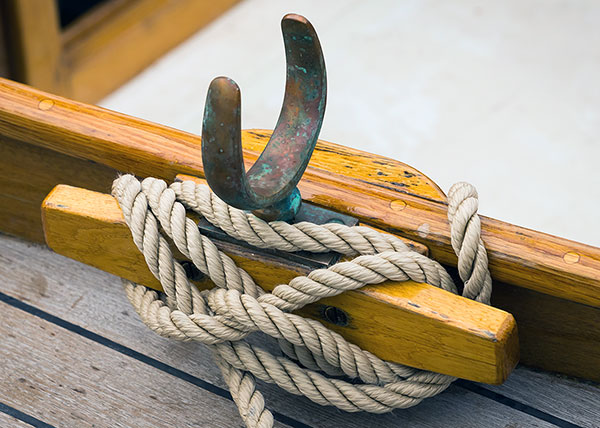
The boat’s hardware is simple and functional: this cleat for the headsail sheet doubles as an oarlock base.
The main positive notes on that tough first day of sailing were the dry cockpit, the constant feeling of overall safety, and the reliability of our electric engine. The dry cockpit was the result of a number of factors: the full bow, the lapstrake planks (which tend to knock down spray), and the ample coaming. Stability was provided by the boat’s wide form, the centerboard, and the combined weight of the batteries, which was about 300 lbs. Although the 48-volt engine was powered by that bank of four very old 12-volt AGM 100Ah batteries, we made headway even with the wind against us. In calm waters, as we would discover later on, we could do 3 knots for more than two hours. Had the batteries been new, according to Giacomo’s experience, we could have done 3 knots for five hours or one hour full-throttle at more than 6 knots. Still, the system was reliable—and silent, thanks to its rubber-belt drive spinning the three-bladed bronze propeller.
Paolo, Clive, and their SPINDRIFT eventually had to withdraw from the trip. The poor power of their electric outboard motor combined with the gloomy weather prevented them from moving forward. Besides, their only headsail was oversized and did not enable them to sail safely, especially with a cameraman aboard. After broaching and kissing the surface of the Loch with their spreaders for a second time, they returned to Gairlochy’s jetty. TAKATANI, on the other hand, took the weather in stride.
We proceeded through the Laggan Locks, then along the skinny Loch Oich. The canal narrowed as it passed through the Scottish Highlands and approached the town of Fort Augustus—from which we would enter Loch Ness. The night we spent in Fort Augustus was one of palpable excitement: the weather forecast, finally, was for favorable winds. With its 18 nautical miles of length and 750′ (230 meters) of maximum depth, Loch Ness is bordered by green slopes that descend gently into its gray waters. The most notable attraction—apart from its famous monster—is the ruins of the millennial Urquhart Castle, located on the northern shore, about two-thirds up the length of the lake.
We left the locks of Fort Augustus on a fresh and unstable southerly, under jib and reefed main. The wind was pretty fresh, and we reached the hull speed of 6.5 knots. TAKATANI maintained a gentle weather helm, even without the mizzen.
As the wind decreased that day, Guido, who had gone ashore, managed to take the most iconic photographs of our journey from Urquhart, with its ruined castle in the foreground and TAKATANI sailing far away in the calm waters of the lake. This was a worthy closure to our journey: in 5 to 7 knots of wind, TAKATANI made 3.5 to 4 knots on a reach and maintained this speed on the wind.
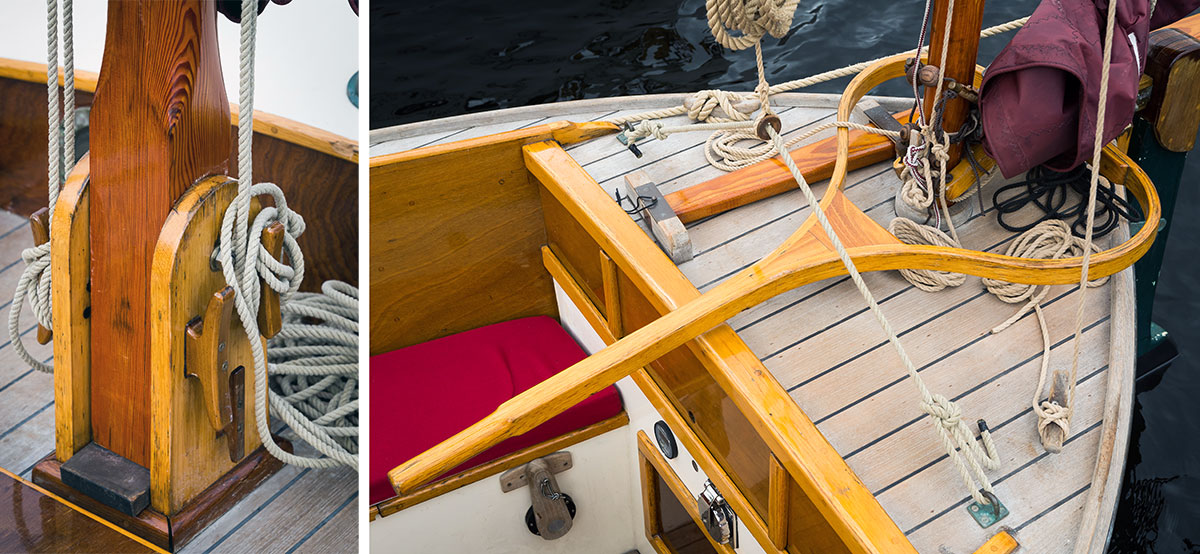
Above left—The mainmast steps in a shop-made tabernacle, allowing for quick rigging and downrigging at the launching ramp. Above right—The tiller for an outboard rudder combined with a yawl rig presents a conundrum, as both items occupy the same space. The elegant solution in the Eun Na Mara design is a laminated loop in the tiller, which allows it to clear the mizzenmast.
Downrigging and Trailer Loading
My memory of Loch Ness will always be one of melancholy due to the approaching end of the adventure and the gradual return to metropolitan life. Per Giacomo’s request, we ended our journey at Caley Marina, just six locks before the fjord of Inverness, because he did not want to damage the trailer’s brakes by dipping them into the salty water of Moray Firth. We met Giacomo there in the early afternoon of Sunday, June 11, and handed TAKATANI back over to him.
Downrigging the boat took less than an hour. The tabernacle system, to quote Giacomo, was “perfect.” With the mast swung horizontal, the bolt on which it swings is driven out, and the spar is secured on deck. The four shrouds are laced to the chainplates and were thus easily released. Because, the mizzenmast is unstayed, removing it was a 10-second job. The forestay, which is secured by two shackles, took about five minutes to release. We lashed the spars on deck, stowed the sails, gaff, and boom, and secured the centerboard. And that was it.
Our transit of the Caledonian Canal in TAKATANI had taken five days. That was somewhat slow but deliberate, because we wanted to enjoy the landscape and record the memory in photographs and video. In theory, the passage can be done in two-and-a-half days, but that would be stressful. Less than that is impossible because of speed limits and the hours of operation of the locks (between 8:30 a.m. to 5:30 p.m. in spring and fall).
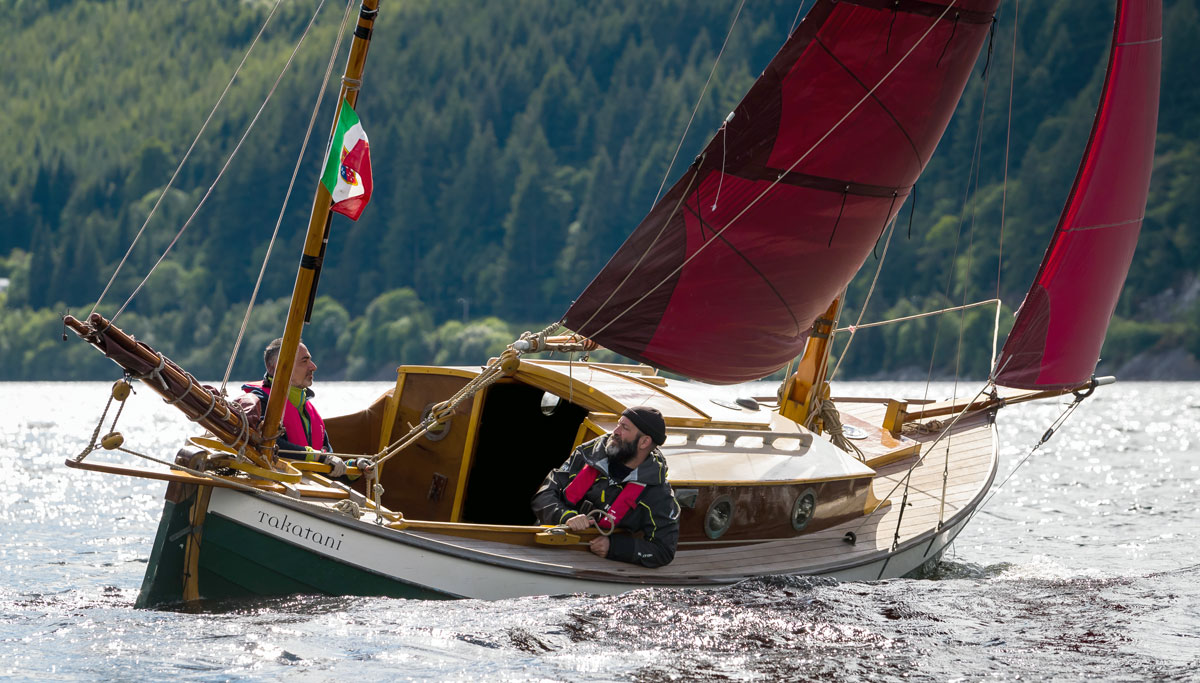
Author Bruno Cianci enjoys a turn at the helm in a fresh breeze; he is accompanied by his longtime friend and shipmate, Andrea Oreni.
The little ship had proven to be ideal for the voyage, and not just because she was dry, seaworthy, and remarkably spacious. She also tied together all the threads of this adventure: We had sailed along the most beautiful waterway of Scotland in a boat built to a design by Iain Oughtred, who lives on Scotland’s Isle of Skye; she was built by an Italy-based shipwright who is also of Scottish origin. And her design, which attracted the attention of hundreds of tourists and locals along the Caledonian Canal, was born of these waters. Had we tried to find a more suitable boat in Scotland, we would have either failed or spent a fortune. 
Bruno Cianci, a journalist, media consultant, and maritime historian, is the author of a number of nautical books. He and his crewmate Alessandro Caricato are the first Italians to have completed the Fastnet Race two-handed. Since 2008, he has been based in Istanbul, where he works as International Press Adviser for the Rahmi M. Koç Museum (see WB No. 241). His Caledonian journey was described in his book Tre Uomini in Barca in Caledonia (Nutrimenti, 2017), which was awarded a Carlo Marincovich Award for journalism in April.
